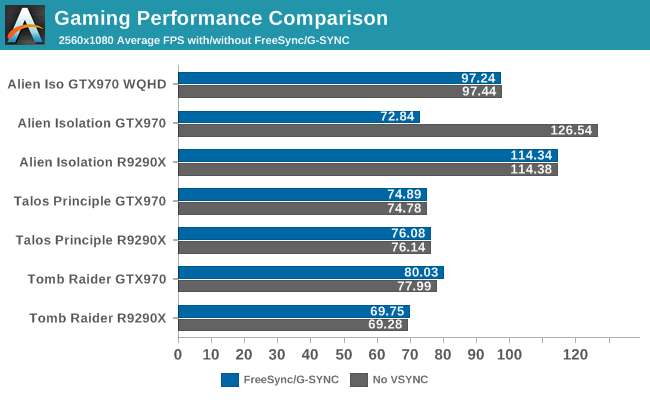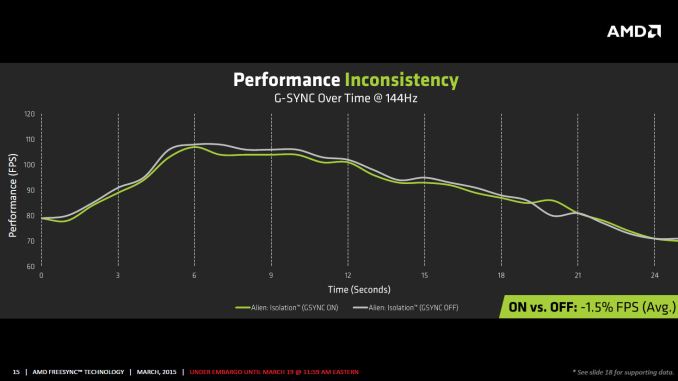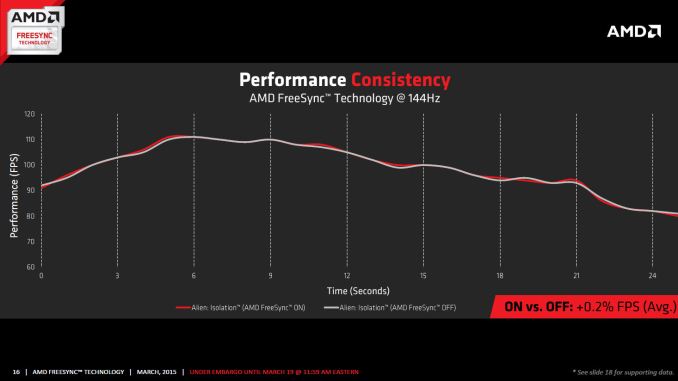The AMD FreeSync Review
by Jarred Walton on March 19, 2015 12:00 PM ESTFreeSync vs. G-SYNC Performance
One item that piqued our interest during AMD’s presentation was a claim that there’s a performance hit with G-SYNC but none with FreeSync. NVIDIA has said as much in the past, though they also noted at the time that they were "working on eliminating the polling entirely" so things may have changed, but even so the difference was generally quite small – less than 3%, or basically not something you would notice without capturing frame rates. AMD did some testing however and presented the following two slides:
It’s probably safe to say that AMD is splitting hairs when they show a 1.5% performance drop in one specific scenario compared to a 0.2% performance gain, but we wanted to see if we could corroborate their findings. Having tested plenty of games, we already know that most games – even those with built-in benchmarks that tend to be very consistent – will have minor differences between benchmark runs. So we picked three games with deterministic benchmarks and ran with and without G-SYNC/FreeSync three times. The games we selected are Alien Isolation, The Talos Principle, and Tomb Raider. Here are the average and minimum frame rates from three runs:


Except for a glitch with testing Alien Isolation using a custom resolution, our results basically don’t show much of a difference between enabling/disabling G-SYNC/FreeSync – and that’s what we want to see. While NVIDIA showed a performance drop with Alien Isolation using G-SYNC, we weren’t able to reproduce that in our testing; in fact, we even showed a measurable 2.5% performance increase with G-SYNC and Tomb Raider. But again let’s be clear: 2.5% is not something you’ll notice in practice. FreeSync meanwhile shows results that are well within the margin of error.
What about that custom resolution problem on G-SYNC? We used the ASUS ROG Swift with the GTX 970, and we thought it might be useful to run the same resolution as the LG 34UM67 (2560x1080). Unfortunately, that didn’t work so well with Alien Isolation – the frame rates plummeted with G-SYNC enabled for some reason. Tomb Raider had a similar issue at first, but when we created additional custom resolutions with multiple refresh rates (60/85/100/120/144 Hz) the problem went away; we couldn't ever get Alien Isolation to run well with G-SYNC using our custome resolution, however. We’ve notified NVIDIA of the glitch, but note that when we tested Alien Isolation at the native WQHD setting the performance was virtually identical so this only seems to affect performance with custom resolutions and it is also game specific.
For those interested in a more detailed graph of the frame rates of the three runs (six total per game and setting, three with and three without G-SYNC/FreeSync), we’ve created a gallery of the frame rates over time. There’s so much overlap that mostly the top line is visible, but that just proves the point: there’s little difference other than the usual minor variations between benchmark runs. And in one of the games, Tomb Raider, even using the same settings shows a fair amount of variation between runs, though the average FPS is pretty consistent.


















350 Comments
View All Comments
5150Joker - Friday, March 20, 2015 - link
NewEgg review LOL! In defense of Jared, he's probably working in the confines of the equipment made available to him by the parent company of this place. TFTCentral and PRAD have really expensive equipment they use to quantify the metrics in their reviews.chizow - Thursday, March 19, 2015 - link
G-Sync isn't going anywhere, but its nice to see AMD provide their fans with an inferior option as usual. Works out well, given their customers are generally less discerning anyways. Overall its a great day for AMD fans that can finally enjoy the tech they've been downplaying for some 18 months since G-Sync was announced.Black Obsidian - Thursday, March 19, 2015 - link
AMD offers an option that's indistinguishable in actual use from nVidia's, and significantly cheaper to boot. Sure, it's not enough for the "discerning" set who are willing to pay big premiums for minuscule gains just so they can brag that they have the best, but who other than nVidia stockholders cares who gets to fleece that crowd?Frankly, I wish that AMD could pull the same stunt in the CPU market. Intel could use a price/performance kick in the pants.
chizow - Thursday, March 19, 2015 - link
Well unfortunately, for less discerning customers, the type that would just take such a superficial review as gospel to declare equivalency, the issues with input lag focuses on minor differences that were not easily quantified or identified, but over thousands of frames, the differences are much more apparent.If you're referring to differences in FPS charts, you've already failed in seeing the value Nvidia provides to end-users in their products as graphics cards have become much more than just spitting out frames on a bar graph. FreeSync and G-Sync are just another example of this, going beyond the "miniscule gains" vs price tag that less discerning individuals might prioritize.
Ranger101 - Friday, March 20, 2015 - link
My heartfelt thanks to chizow. Your fanboy gibberings are a constant source of amusement :)chizow - Friday, March 20, 2015 - link
Np, without the nonsense posted by AMD fanboys there wouldn't be a need to post at all!Black Obsidian - Friday, March 20, 2015 - link
You're so discerning that I'm sure you could wax poetical on how your $3K monocrystalline speaker cables properly align the electrons to improve the depth of your music in ways that aren't easily quantifiable.chizow - Friday, March 20, 2015 - link
No, but I can certainly tell you why G-Sync and dozen or so other features Nvidia provides as value-add features for their graphics cards make them a better solution for me and the vast majority of the market.silverblue - Friday, March 20, 2015 - link
A dozen? Please.No really, I mean PLEASE tell us this "dozen or so other features".
chizow - Friday, March 20, 2015 - link
Np, always nice mental exercise reminding myself why I prefer Nvidia over AMD:1. G-Sync
2. 3D Vision (and soon VRDirect)
3. PhysX
4. GeForce Experience
5. Shadowplay
6. Better 3rd party tool support (NVInspector, Afterburner, Precision) which gives control over SLI/AA settings in game profiles and overclocking
7. GameWorks
8. Better driver support and features (driver-level FXAA and HBAO+), profiles as mentioned above, better CF profile and Day 1 support.
9. Better AA support, both in-game and forced via driver (MFAA, TXAA, and now DSR)
10. Better SLI compatibility and control (even if XDMA and CF have come a long way in terms of frame pacing and scaling).
11. Better game bundles
12. Better vendor partners and warranty (especially EVGA).
13. Better reference/stock cooler, acoustics, heat etc.
Don't particularly use these but they are interesting to me at either work or in the future:
14. CUDA, we only use CUDA at work, period.
15. GameStream. This has potential but not enough for me to buy a $200-300 Android device for PC gaming, yet.
16. GRID. Another way to play your PC games on connected mobile devices.
Damn, was that 16? No sweat.